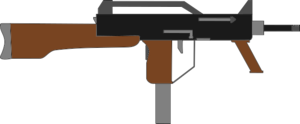MP-57: Difference between revisions
(→Design) |
|||
| Line 108: | Line 108: | ||
==Variants== | ==Variants== | ||
*MP-57/U: Integrally suppresed version used by special units of the [[Royal Lyngaardian Army]] and the [[HIR]]. | |||
*MP-57/OK: Has cut outs made to accept mounts for optic devices. | |||
*MP-57/OKU: MP-57/U with the optic mount cuts. | |||
*MP-57/88: Revised version, made with reinforced aluminum stamptings. | |||
*MP-57/F: folding stock variant | |||
*MP-57/88F: MP-57/88 with folding stock | |||
*MP-57/12: Revised version of the MP-57 with new plastic furneture, a folding stock, new optic cut, threaded barrel, and Picitinny rails in place of older plastic foregrip. | |||
==Users== | ==Users== | ||
*{{flagicon|Insaeldor}} [[Lyngaard]] | *{{flagicon|Insaeldor}} [[Lyngaard]] | ||
Revision as of 15:31, 27 July 2022
| Maskinpistol 1957 | |
|---|---|
 | |
| Type | Submachine gun |
| Place of origin | |
| Service history | |
| In service | 1957-Present |
| Used by | |
| Production history | |
| Designer | Eugène Fønss |
| Designed | 1949-1954 |
| Manufacturer | Guldbæk & Kjer Group |
| Produced | 1955-Present |
| Specifications | |
| Weight | 3.5 kg |
| Length | 640 mm |
| Barrel length | 260 mm |
| Cartridge | 9x19mm MagSec |
| Action | Open-bolt Blowback |
| Rate of fire | 450 rpm |
| Effective firing range | 200m |
| Feed system | 32-round detachable box magazine |
| Sights | Ghost ring iron sights |
The MP-57 is a Submachinegun and has been used by the Royal Lyngaardian Armed Forces since 1957. Adopted to replace the Model 30 Submachine Gun in army service. Desisgned to be used by vehicle crews, security, and special forces, the MP-57 was widly adopted within the army and has seen success in foreign markets. The MP-57 was designed by Eugène Fønss, commander of the 3. Marinekommando Brigade with the intent of creating a lightweight, manuverable, and simple firearm for use by soldiers. The firearm was manufactured by the Guldbæk & Kjer Group with several variants in prooduction.
History
The MP-57 was made by Eugène Fønss to fill in a gab he felt existed in infantry capabilities. During decolonialization conflicts in Mauria he noticed that the forces he commanded lacked effective mobile fire to supress enemy forces, using the Tjenestegevær 05 and the ISMG 20 Machine gun saw forces being unable to move and attack effectively. While Lyngaardian forces did use the Model 30 Submachine Gun it was commonly meligned for being too heavy, too long, and unreliable. When Fønss returned home he set out to design a better infantry fighting weapon.
Fønss would make several prototypes in his back yard, by his 3rd prototype he had also started writing for Jægeren Månedlig. He would make articles detailing his work monthly. this would get the attention of Karl Wiehe, who worked for Guldbæk & Kjer Group. Wiehe would send the magazine articles to Founding Partner Alois Guldbæk. Guldbæk had been looking to start development on a new submachine gun after rumors from the armies Ordinance and Procurment Department was looking for a replacement for the Model 30 Submachine Gun. Guldbæk would buy the rights to the prototypes from Fønss and would then task chief engineer Viggo Jacobsen with revising the designs.
The original framework from the Fønss prototypes was maintained, Jacobsen would simplify the manufacturing requirments by creating a stamped metal reciever. he would also add in the spring loaded dust covers to the ejection port and the chaarging handle, as well as adding a second cut out for the charging handle, making the firearm fully ambidextrous. he would add a rate reducing mechanism and the grip saftey. finally the Fønss-Jacobsen Experimental Machine Pistol 1 (FJEMP .mk1) was submitted to testing for the military.
the firearm would go through several itterations through a year long testing regiment from 1955 to 1956. This included use in mock up force-on-force training, Ice, Mud, Water, and sand testing. the Ordinance and Procurment Department would formally accept the gun as the MP-57 after passing all tests within acceptable peramiters.
Design
the MP-57 is a blowback operated Submachine gun utilizing a Telescoping bolt which greatly reduces the length of the firearm, with the magazine in the grip also contributing the the short nature of the gun. The firearm is made out of two stamped halves of the main reciever, welded together. The stock and forgrib are made of a wood impressed bakelite designed to be light and durable. The MP-57 is a downward ejecting firearm, with a spring loaded dust cover over the ejection port. the Charging handle was operable on both sides using large knobs with a rubber coating. There is no fire selector and manipulative saftey. There is a grib saftey which prevents the sear from moving when not engaged as well as an internal magazine saftey. the MP-57 fires at around 450 rounds per minute, allowing for controlled fire. The MP-57 also uses a ghost ring rear iron sight.
The MP-57 set the standard for other firearms that would be adopted by the Lyngaardian military in years to come. Its ambidextarity would lead the way for future weapon systems like the TG-69 assault rifle. Its ghost ring sights would be emulated on both the TG-69 and the TP-68 Pistol. a similar spring loaded dust cover would be emulated onto the TG-69 as well.
Variants
- MP-57/U: Integrally suppresed version used by special units of the Royal Lyngaardian Army and the HIR.
- MP-57/OK: Has cut outs made to accept mounts for optic devices.
- MP-57/OKU: MP-57/U with the optic mount cuts.
- MP-57/88: Revised version, made with reinforced aluminum stamptings.
- MP-57/F: folding stock variant
- MP-57/88F: MP-57/88 with folding stock
- MP-57/12: Revised version of the MP-57 with new plastic furneture, a folding stock, new optic cut, threaded barrel, and Picitinny rails in place of older plastic foregrip.